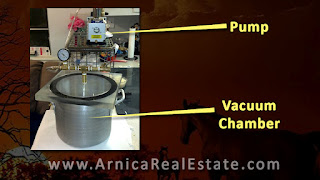While I was making that mold, I whipped out my trusty camera phone and shot a short video of what the rubber looks like while we're sucking the air out of it in the vacuum chamber. It's not much of a video (just 2 minutes), but I think you'll all get a kick out of watching the rubber bubble around as it "came alive."
If you'd like to watch it over at YouTube, Click Here.
More About Molds
You see, molds don't last forever. As they age they get brittle and lose the slickness that is necessary for the easy removal of the cured resin. Without this slickness, the mold fails and tears when you pull out the finished piece. One question that's been asked a lot is, "How long do these molds last?"
 |
| The Arnica Work Table |
Well, pilgrim, there ain't no good answer for that. You see, we use different types of silicone mold rubber and they each have different properties. As you can see in this picture, we use three types of rubber: purple, green and yellow.
Yeah, I know it's more of a teal or a turquoise or soa foam... I'm a guy working with chemicals and power tools. Right now, I'm just going to call it "green."
Each of these is slightly different. The yellow is made by a major company called Alumilite. We use their Quick Set Mold Silicone which sets in about half an hour (and completely solidifies in 4 hours). This is a good, fairly stiff rubber that is good for holding details and is justly famous for its long-life and durability. It's a bit expensive (the boardwalk mold had 410 grams of rubber and cost about $20 to make). That might not sound like much, but when you consider we've got 40+ molds... well, it adds up. We also have to be careful of that stiffness, as it can make it harder to de-mold smaller parts.
 |
| A look at the pump and the pot (vacuum chamber) |
The Green is the 2125 from MPK Enterprises. The company is run by a guy by the name of Mike, and he's one of the nicest and most helpful guys out there. You can reach him through his site at www.hobbysilicone.com. This particular silicone rubber is very flexible which makes it ideal for small parts like the awning posts you can see in the photo above. It also has the advantage of holding details very well. In addition to small pieces, we use it for some of the roofs, as the flexibility makes it easy to de-mold the large flat panels. Finally, it only runs about $10 a pound, so it's less expensive than the Alumilite.
The purple is the pleased spiritualist -- er, I mean "happy medium" between the two. We use MPK's Extra-Firm 135 because it's more flexibile than the Alumilite, but more rugged than the green. If I had to pick just one rubber to use for all occasions, I would choose the purple. Fortunately, I don't have to pick just one. As with any job, you need to use the right tool for the task at hand. Figuring out which rubber matches which mold master is a bit of an art, but I'm getting better at it.
Just as there are different molds for different situations, we use different resins for different applications. Come back next week and we'll talk more about why sometimes we use white resin and sometimes we use tan.
See ya then, amigos!


No comments:
Post a Comment